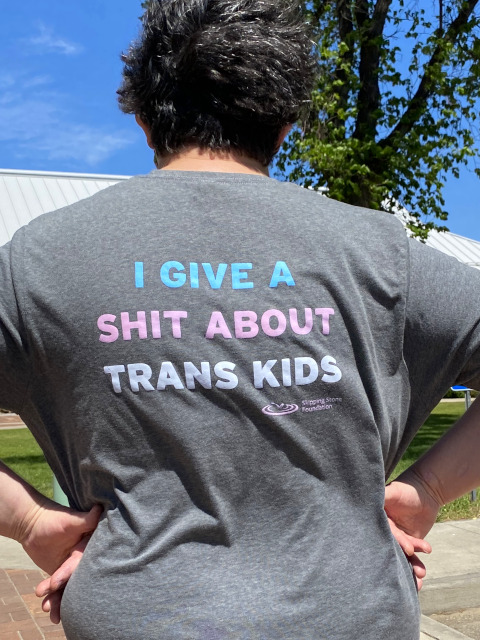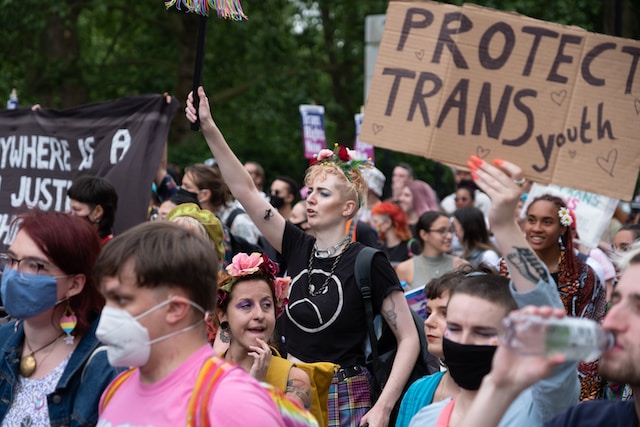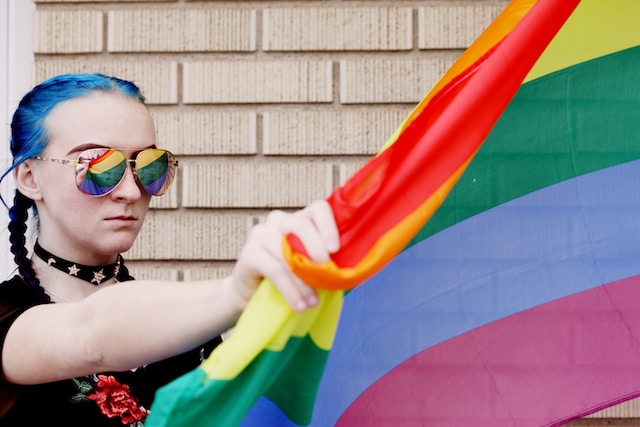Validation Through Language: The Significance of Proper Pronoun Use with Transgender Youth
Learn why using proper pronouns is essential in creating inclusive spaces for transgender individuals. This blog post provides strategies for using pronouns correctly, highlights the impact of being misgendered, and emphasizes the importance of creating more resources that meet the unique needs of transgender individuals. By increasing education and awareness, we can create a more just and equitable society for all.
Introduction: Giving Voice to Transgender Youth Through Pronoun Respect
Using the correct pronouns is like giving a voice to a transgender youth, allowing them to express their true selves to feel seen and heard.

Imagine waking up every morning, dreading the moment when you have to leave the comfort of your bed and face a world that doesn’t accept you for who you genuinely are. Imagine feeling like a stranger in your own skin, your heart sinking as you hear a name that doesn’t match who you sincerely are.
The weight of each misgendered pronoun feels like a blow to your sense of self. It’s like a sharp knife carving away at your identity, leaving you feeling invisible and insignificant. It’s a crushing weight on your shoulders, a constant reminder that you’re living in a world that refuses to acknowledge your existence and denies you the right to be yourself.
This feeling is not unique, as countless transgender youth face daily bullying, discrimination, and mental health struggles, which cannot be overlooked or dismissed. Yet, we cannot ignore this reality any longer and must take action to create a more inclusive society for transgender youth.
Using the correct pronouns is fundamental to respecting an individual’s gender identity and acknowledging their sense of self. Being misgendered feels like a physical blow, triggering a wave of dysphoria that can leave you feeling disconnected from your body and your sense of self.
This blog post explores the importance of using proper pronouns with transgender youth and provides actionable strategies. By asking for pronouns, practicing gender-neutral language, and correcting mistakes, we can create a more inclusive and accepting environment for transgender youth. It’s imperative to recognize the need for increased education and awareness around pronoun use and acknowledge language’s significant role in creating safe and welcoming spaces for transgender youth.
The Importance of Proper Pronoun Use:
We must use correct pronouns to show respect and validation for a transgender youth’s gender identity. Imagine constantly feeling disrespected and invalidated because people refuse to acknowledge who you genuinely are. Using the correct pronouns for transgender youth is like giving them a life raft in a stormy sea. Imagine being tossed around in the waves of dysphoria, feeling like you’re drowning in a sea of invalidation and disrespect. But when someone uses your correct pronouns, it’s like a lifeline that helps you stay afloat. You can breathe easier and feel more connected to the world around you.

Conversely, when someone uses the wrong pronouns, it can be a painful experience for transgender youth, making them feel dehumanized and misunderstood. Constant invalidation can feel like an overwhelming weight, pushing down on transgender youth. This invalidation can trigger intense feelings of depression, anxiety, and hopelessness.
But the statistics tell an even more harrowing story. According to The Trevor Project’s 2020 National Survey on LGBTQ Youth Mental Health found that TGNByouth who reported having their pronouns respected by all or most of the people in their lives attempted suicide at half the rate of those who did not have their pronouns respected (The Trevor Project, 2020).
This means that using the correct pronouns isn’t just a minor act of kindness but a vital step in protecting the mental and emotional well-being of transgender youth. When we use the correct pronouns, we send a powerful message of respect and validation for a person’s gender identity. It’s a small but significant act that can make a huge difference in someone’s life. In addition, it can help create a more inclusive and accepting environment for everyone.
By using the correct pronouns for a transgender person, we demonstrate respect and validation for their gender identity and affirm their humanity and right to self-determination. Each pronoun is like a puzzle piece that fits perfectly into place, helping to reveal the complete picture of who that person truly is. It’s like opening a window and letting in the fresh air and sunlight, creating a sense of clarity and openness that fosters a more inclusive and accepting environment for all. In this way, we help to complete the puzzle of their identity and allow their true self to shine through.
The Negative Impact of Misgendering:
When someone misgenders me, it feels like a knife twisting in my gut. When someone invalidates me, it feels like a punch in the stomach that knocks the wind out of me, leaving me feeling frustrated and gasping for breath.

Many people fail to understand the importance of using the correct pronouns, which invalidates and hurts transgender youth. Instead, they say things like, “It’s hard for me too,” which shows they’re more concerned with their own discomfort than respecting Transgender identities. But it’s essential to remember that misgendering is incredibly damaging to a transgender person’s self-worth and self-esteem, especially our youth. It’s like being hit by a tidal wave of shame and self-doubt that leaves them feeling small and insignificant. Using the wrong pronouns sends a message that the transgender individual’s identity is not respected or valued; instead, your own discomfort is more important. So, the next time you struggle to use the proper pronouns, remember that it’s not about you. It’s about respecting the dignity and identity of the transgender person in front of you.
Being misgendered is like the stench of rotting garbage, suffocating and impossible to ignore.
A survey of transgender and gender non-conforming youth by the Human Rights Campaign found that being referred to by their chosen name and pronouns was associated with lower rates of depression and suicidal ideation (Human Rights Campaign, 2018).
Pronouns are a vital aspect of a transgender youth’s identity, not a choice, and misgendering can cause significant emotional pain. They are like the foundation of a house, providing a stable base for a person’s sense of self. When pronouns are not respected, the structure can crumble, leaving the person feeling lost and adrift.
For transgender youth, their pronouns represent an essential part of who they are and how they see themselves. Imagine feeling like you are trapped in a body that doesn’t match who you are on the inside and then having someone repeatedly refer to you with the wrong pronouns. It’s like being stripped of your identity and forced to wear a costume that doesn’t fit.
The experience of being misgendered can be suffocating, like a weight crushing the chest and a lump in the throat, tearing away one’s identity. It can feel like you’re drowning in a sea of uncertainty, struggling to find solid ground to stand on. When someone uses the wrong pronouns, they invalidate the transgender youth’s gender identity and suggest it’s up for debate. This can leave deep emotional scars that can take years to heal.
A survey by the National Center for Transgender Equality found that 32% of transgender and nonbinary individuals who have interacted with law enforcement reported being verbally harassed, and 6% reported being physically assaulted because of their gender identity (National Center for Transgender Equality, 2015). Proper pronoun use can help reduce the harassment and violence transgender youth face from law enforcement and others who refuse to recognize their gender identity, which provides a sense of safety and dignity.
Using the correct pronouns shows transgender youth that we see, hear and value them, which can transform their mental and psychological well-being. It’s like watering a plant that’s been wilting in the sun. Suddenly, it springs back to life, bursting with vibrant colours and energy. Just imagine what it’s like to face misgendering and invalidation day after day. It’s like carrying a heavy weight that suffocates you and makes you feel like an outsider. But when we use the correct pronouns, it’s like a beam of light that shines on these youth, offering them acceptance and belonging. It’s like wrapping them in a warm embrace that affirms their true selves and changes their lives forever.
The Prevalence of Pronoun Misuse:
The prevalence of pronoun misuse significantly harms and invalidates transgender youth. Learning about gender-neutral pronouns and the importance of using someone’s correct pronouns is critical to ensuring respectful and validating interactions with transgender youth. By understanding and using pronouns correctly, individuals can help create a more inclusive environment for transgender youth, where they feel respected and validated in their gender identity.

Unfamiliarity with gender-neutral pronouns and the importance of using someone’s correct pronouns contribute to the frequency of pronoun misuse and can negatively impact transgender youth’s mental health outcomes. Research demonstrates that misgendered transgender youth experience higher rates of depression and anxiety, as well as an increased risk of suicide attempts (Haas et al., 2014; James et al., 2016). Imagine constantly correcting people on your pronouns, day in and day out. It’s like being on a never-ending rollercoaster ride of frustration and disappointment. It’s emotionally exhausting and takes a toll on one’s mental health.
One factor contributing to the prevalence of pronoun misuse is a lack of education and awareness. Many individuals may not be familiar with gender-neutral pronouns or may not understand the importance of using someone’s correct pronouns. This lack of understanding can lead to unintentional misgendering, which can still significantly impact transgender youth. Education around pronoun use is essential to ensure that individuals can interact with transgender youth in a respectful and validating manner. This education can take many forms, such as workshops, training, or online resources.
In addition to education, there is also a need for increased resources to support the use of proper pronouns. This can include tools such as gender-inclusive language guides, which provide guidance on the use of gender-neutral language and pronouns. They are like roadmaps that lead individuals toward using the proper pronouns. They provide a framework for respectful and validating language and help remove the guesswork and uncertainty that can lead to misgendering. They’re like a toolkit that equips individuals with the knowledge and skills they need to be more inclusive and supportive. These resources can help promote awareness and education around pronoun use and provide individuals with the tools they need to use pronouns correctly. In addition, providing these resources can help to create a more inclusive environment for transgender youth, where they feel respected and validated in their gender identity.
The occurrence of pronoun misuse is a significant issue that can have a negative impact on mental health outcomes for transgender youth. Education and awareness around pronoun use is essential to promoting respectful and validating interactions with transgender youth. Providing resources to support proper pronoun use can also help create a more inclusive environment for transgender youth. The importance of using someone’s correct pronouns cannot be understated. It’s like a key that unlocks the door to validation and acceptance. When someone uses the correct pronouns, it’s like a warm hug that says, “I see you, and I accept you for who you are.” By promoting appropriate pronoun use, individuals can help improve mental health outcomes and create a more inclusive society.
Discover our Online Resources for Queer Support, providing valuable information, sensitivity training, and resources on proper pronoun use and fostering inclusivity. Empower yourself to make a positive difference and create a world that embraces and uplifts everyone.
Strategies for Using Pronouns Correctly:
Using pronouns correctly is essential to demonstrate respect and validation for transgender youth. However, using pronouns correctly can be challenging, especially when interacting with youth who use gender-neutral pronouns. It’s essential to ask for pronouns, introduce yourself with your pronouns, and consistently use the youth’s preferred pronouns. Fortunately, there are several strategies that individuals can use to ensure that they are using pronouns correctly.

One effective strategy for using pronouns correctly is to ask for pronouns. The Trevor Project Guide to Becoming an Ally to Transgender and Nonbinary Youth suggests that the best way to confirm a person’s pronouns is by asking or by introducing yourself with your pronouns, to give the person an opportunity to share theirs. Parents, other family members, school staff, health professionals, and other individuals in the youth’s lives can best support them by asking for and consistently using their pronouns. Affirming gender in school and workplace settings can begin by having a practice of sharing pronouns for everyone and setting the expectation that all individuals will have their pronouns respected by others (The Trevor Project, 2020).
It is important to note that not all transgender youth use the same pronouns, and some may prefer gender-neutral pronouns. As such, asking for and respecting an individual’s pronouns is crucial.
Another strategy for using pronouns correctly is to practice using gender-neutral pronouns. While gender-neutral pronouns may be unfamiliar to some individuals, they are an important way to respect and validate individuals who do not identify within the gender binary. Examples of gender-neutral pronouns include they/them/theirs, ze/hir/hirs, and ey/em/eir.
To practice, get in the habit of using the correct pronouns when thinking of that person, “They are so good at baking,” instead of “He/she is so good at baking.” If you mess up their pronouns as you think about them, correct yourself and then try harder. The same will work for someone going from male to female pronouns or vice-versa.
Using gender-neutral pronouns may initially feel unfamiliar, but it’s an essential step in showing support for youth who identify outside of the gender binary. Try incorporating they/them pronouns into your everyday language, and notice how it changes how you think about gender. Instead of automatically assuming someone’s gender, you can recognize and honour their identity. In addition, by practicing gender-neutral pronouns, individuals can become more comfortable using these pronouns in various settings.
Mistakes happen, but how we handle those mistakes matter. Individuals will inevitably make mistakes when using pronouns, especially when first learning how to use gender-neutral pronouns. Correcting a misstep can feel uncomfortable, but it’s a sign of respect and shows commitment to creating an inclusive environment. Corrections can be done by apologizing for the error and using the correct pronoun going forward. By taking responsibility for mistakes and making an effort to use pronouns correctly, individuals can demonstrate their commitment to respecting and validating transgender youth.
Using pronouns correctly is a prominent way to demonstrate respect and validation for transgender youth. Strategies for using pronouns correctly include asking for pronouns, practicing gender-neutral pronouns, and correcting mistakes. Using these strategies, individuals can create a more inclusive environment where transgender youth feel respected and validated in their gender identity.
The Role of Language in Creating Inclusive Spaces:
Language plays a crucial role in creating inclusive spaces for transgender youth. We must pay attention to every detail to build a genuinely inclusive environment. One vital aspect is using proper pronouns. By doing so, we acknowledge and honour transgender youth’s gender identity, and create a welcoming and validating environment for everyone. By using the correct pronouns, individuals can demonstrate respect and validation for transgender youth and create a more inclusive environment where transgender youth feel safe and welcome.

Using the appropriate pronouns can make all the difference in creating an inclusive environment for transgender youth. As a transgender, I know firsthand the impact of being misgendered. It’s like a punch in the gut, a reminder that the world doesn’t see me for who I am. The emotional weight of being referred to by the wrong pronoun can be crushing, leading to feelings of anxiety, dysphoria, and even depression. But, on the other hand, being addressed with my correct pronouns is like a warm embrace, a validation of my identity and shows I am seen and heard. It’s a small but significant act of kindness that can make a world of difference in the mental health and well-being of transgender youth.
Research shows that when we use preferred pronouns for transgender youth, we’re actively supporting their mental health and well-being. For example, according to a study published in the Journal of Adolescent Health, transgender youth are less likely to experience suicide ideation when we use their preferred pronouns (Marcellin et al., 2020). And the Journal of Counseling Psychology published an article that discusses the importance of using preferred pronouns as a way to support the mental health and well-being of transgender youth(Sullivan, 2016).
Creating a sense of safety and belonging is a primary aspect of inclusive spaces for transgender youth. Inclusive spaces are those where individuals feel safe and welcome, regardless of their gender identity. When individuals feel secure and welcome, they are more likely to participate in social and community activities, seek healthcare services, and engage in other aspects of society.
Creating inclusive spaces requires deliberate action. For instance, we can provide gender-neutral restrooms, use gender-neutral language, and train staff on transgender issues. By doing so, we cultivate environments where transgender youth feel safe, seen, and heard, fostering a sense of belonging and community. By creating inclusive spaces, individuals can help to promote a sense of safety and belonging for transgender youth and create a more welcoming environment for all.
Lastly, language plays a crucial role in creating inclusive spaces for transgender youth. Proper pronoun use is just one aspect of creating an inclusive environment, but it is paramount. By using the correct pronouns, individuals can demonstrate respect and validation for transgender youth and create a more inclusive environment where these youth feel safe and welcome.
Conclusion:
Properly using pronouns is essential to creating inclusive spaces for transgender youth. By using the correct pronouns, people can demonstrate respect and validation for transgender youth and create a more inclusive environment for all.
We can create inclusive spaces for transgender youth by implementing various strategies, such as providing gender-neutral restrooms, using gender-neutral language, and training staff on transgender issues. In addition, it is imperative for people to recognize the prevalence of pronoun misuse and take steps to increase education and awareness around the issue.
Furthermore, we must prioritize creating more resources that meet the unique needs of transgender youth. These needs include resources such as healthcare services, educational programs, and support groups specifically designed to meet the needs of transgender youth. By increasing resources, people can help to foster a sense of safety and belonging for transgender youth and create a more welcoming environment for all.
Conclusively, using pronouns correctly is a crucial way to demonstrate respect and validation for transgender youth. Strategies for using pronouns correctly include asking for pronouns, practicing gender-neutral pronouns, and correcting mistakes.
Using these strategies, people can create a more inclusive environment where transgender youth feel respected and validated in their gender identity. Additionally, people must take responsibility for their actions and educate themselves on the issues facing transgender youth. Only then can we create a more just and equitable society for all.
Bibliography:
-
The Trevor Project. (2020). 2020 National Survey on LGBTQ Youth Mental Health. Retrieved from https://www.thetrevorproject.org/survey-2020/
-
National Center for Transgender Equality. (2020). Know your rights: Gender identity discrimination. https://transequality.org/know-your-rights/gender-identity-discrimination
-
Human Rights Campaign. (2018). Supporting and caring for transgender children. Retrieved from https://www.hrc.org/resources/supporting-caring-for-transgender-children
-
National Center for Transgender Equality. (2015). Report of the 2015 U.S. Transgender Survey. Retrieved from https://transequality.org/sites/default/files/docs/usts/USTS-Full-Report-Dec17.pdf
-
Haas, A. P., Rodgers, P. L., & Herman, J. L. (2014). Suicide attempts among transgender and gender non-conforming adults: findings of the National Transgender Discrimination Survey. American journal of public health, 104(3), e27-e34.
-
James, S. E., Herman, J. L., Rankin, S., Keisling, M., Mottet, L., & Anafi, M. (2016). The Report of the 2015 U.S. Transgender Survey. National Center for Transgender Equality.
-
National LGBTQ Task Force. (2018). Transgender terminology. Retrieved from https://www.thetaskforce.org/wp-content/uploads/2018/09/Transgender-Terminology.pdf
-
Marcellin, L. H., Bartholomaeus, C., Spieldenner, A., Arayasirikul, S., Pang, V., Raymond, H. F., & Bauermeister, J. A. (2020). Preferred names, pronouns, and gender identity documentation in a national sample of transgender and gender nonbinary U.S. youth. Journal of Adolescent Health, 67(6), 705-711.
-
Sullivan, E. L. (2016). Pronouns matter: Transgender and genderqueer individuals’ experiences of pronoun use and misuse. Journal of Counseling Psychology, 63(2), 127-137.
-
GLAAD. (n.d.). Tips for allies of transgender people. Retrieved from https://www.glaad.org/transgender/allies
-
The Trevor Project. (2020). Pronouns Usage Among LGBTQ Youth. Retrieved from https://www.thetrevorproject.org/research-briefs/pronouns-usage-among-lgbtq-youth/


Leave a comment